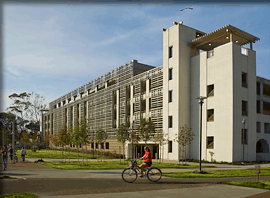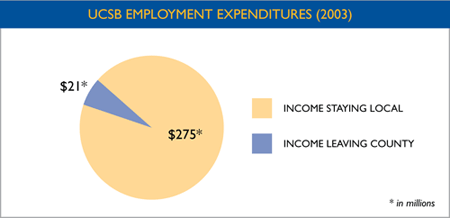
UC Santa Barbara has a positive influence on California, and especially the South Coast. With over 6,500 degrees conferred each year, UCSB makes a large contribution to the economic health and cultural diversity of the region. The University's $1 billion impact accounts for 5.3% of the total Santa Barbara County economy, making it one of the county's single biggest economic engines. Between the Gaviota Pass and Ventura County line, UC Santa Barbara represents 11.6% of the local economy. Over 90 local companies were founded by UC Santa Barbara graduates and faculty. Every dollar spent by UC Santa Barbara campus operations yields an additional 72% benefit to the Santa Barbara economy.
By the Numbers
UCSB is more than an educational institution. It is a member of the local community and an important economic resource.
$1 billion
Overall annual economic
impact of UCSB
$223 million
Student spending on rent
and mortgage payments
9,500 = (6,000 full time)
Number of UCSB employees
11.6%
Portion of the local economy
between Gaviota Pass and Ventura
County line directly attributed to UCSB
$295 million
UCSB annual payroll
$64 million
Student spending on
food and entertainment
90
Local companies created
by UCSB grads
UCSB faculty and staff, including their spouses and family, have a strong sense of social responsibility for the Santa Barbara region. Faculty and staff spend an average of about 10 hours a month in volunteer activity, while half their spouses spend about the same amount. This includes community education, youth and childcare programs, the environment, and arts and cultural events. Students volunteer with the community: 63% of undergraduates spend about 9 hours a month, while almost half of graduates spend 8.5 hours a month.
Faculty and staff of UCSB contribute a significant amount of money through donations to charities and organization in the tri-county* region. Staff donated $7.4 million in the same year, at an average of $1,154 per person. Faculty donated over $1.2 million at an average of $1,419 per person in 2004 alone. Undergraduate and graduate students together donated over $1.3 million.
* San Luis Obispo, Santa Barbara, and Ventura Counties
Research at USCB has two payoffs: the first is when money is spent for the products, services, and participants needed to carry out various studies and experiments, while the second payoff is in overall innovative advancements such as increased productivity and new technologies and products. These advancements contribute to the productivity of the region as a whole, as social capital gravitates to centers of intellectual and creative output.
In addition to over a hundred faculty members as elected members or fellows of the American Academy of Arts and Sciences, the National Academy of Sciences, the National Academy of Engineering, and the American Association for the Advancement of Science, there are five Nobel Prize winners, recognized for their landmark contributions in research to the fields of chemistry, economics, and physics.
Research centers include institutes focused on theoretical physics, electronic structures, materials, nanotechnology, optoelectronics, earthquakes, earth systems science, polymers and organic solids, marine sciences, neuroscience, quantum mechanics, astrophysics and cosmology, linguistics, Black studies, Chicano studies, global climate change, humanities, and ecological systems.
Improving the quality of the workforce is a key to economic innovation and productivity. UCSB plays a central role in enhancing the skills of the regional workforce. In 2006 alone, over 6,500 degrees were conferred, primarily to students of Letters and Science and Engineering. Each new engineering graduate has a real economic output of at least $67,000 in the greater LA region. In helping California to remain a leader in the knowledge-based global economy, the entire UC system has increased its conferral of engineering degrees by 2.7% annually, while the national rate has declined 1.8%.
Thousands of UCSB faculty, staff, and students are engaged in various activities that benefit the region socially and culturally. UCSB Arts & Lectures provides performances, lectures, and other special events in collaboration with numerous local organizations. This 45-year long performance history includes ballet, dance, theater, jazz and classical music, film, poetry and other literary events. Also, a diverse range of public lectures cover topics in culture, art, science, and politics, offering attendees an accessible and affordable forum for relevant issues.
The UCSB Library is open to the public. In 2001, more than 15% of the total borrowing from these libraries was from non-UC patrons. Public tours of other facilities are available, including museum exhibitions, the herbarium, vertebrate and invertebrate collections from around the world, and artifact collections from local archeological sites.
The University, along with local community groups, has played an active role in preserving through the LRDP biologically sensitive sites with endangered species, native plants, and unique landscapes. These natural reserves are open to the public and have docent- or self-guided tours and special activities to educate children and adults on the process of habitat restoration.
A major facet of how UC Santa Barbara benefits the local and regional community is by its extensive continuing education, concurrent enrolment, and certificate programs offered through the UCSB Extension. It offers classes to adults on a year-round basis, with evening and weekend classes as well as week-long workshops. Professionals can participate in specialty training to enhance their careers and working adults have the opportunity to pursue their degree part-time. Special areas of study include cross-cultural development, English as a second language, physical sciences, California history, writing, mathematics teaching ability, and effective learning methods in general for teachers.
The University also engages in extensive K-12 outreach, involving youths in field trips, tours, demonstrations, talks, summer art and science camps, musical and dance performances, career guidance sessions, and workshops for the teachers themselves. Both the College of Engineering and the College of Letters and Science help prepare youths for college, allowing them to take UCSB courses in their junior and senior high school years. These programs stem from a strong commitment from UCSB to motivate young students to learn, and in the process improving academic standards.
In addition to offering community spectators exciting intercollegiate sporting events, UCSB's Exercise and Sport Studies Department offers year-round and summer-only programs geared toward involving members of the community. Programs include aquatics, gymnastics, wine tasting, sailing, aerobics, yoga, ceramics, and community athletic coaching. Summer offerings include surfing, kayaking, swimming, snorkeling, basic lifeguard and rescue skills, weight-training, racquetball, and swimming.
Students contribute significantly to the local economy while they attend school and pay for living expenses. Over $223 million was spent locally on student rent and mortgage payments in 2007 alone, as well as $64 million on food and entertainment in the same year.
Of all the expenditures associated with the University, 53% is spent by students and visitors, at over $596 million annually. Undergraduates spend the bulk of this money, at over $500 million, with graduates spending over $70 million. Most of this money is spent locally, due to the nature of having to live relatively close to school. The following table shows how much money students spend and how much stays local (see Figure 3).

Figure 3 *in millions
In the 2006-2007 school year, there were over 102,000 visitors to UC Santa Barbara, spending over $26 million during the course of their stay. This money goes to local hotels and restaurants, as well as local governments for sales and other taxes incurred. Visitor activity associated with the University accounts for 2-3% of total county tourism.
UC Santa Barbara is the largest employer in the county by a wide margin at 9,500 employees in 2007 (see Figure 1). This is double the next largest employer. This is not without effect on other sectors of the County. Employees must find housing in this very competitive and expensive market. To offset this impact, the University's Long Range Development Plan proposes providing approximately 1,800 additional faculty and staff housing units, 5,500 additional bed spaces and 240 more student family units.

Of the $295 million spent on annual employment, 93% stays within the county, paying $275 million to local employees (see Figure 2).

Most of UC Santa Barbara's revenue comes from outside Santa Barbara County from sources such as state and federal funding, education loans, research grants, and sales from educational services to residents outside the area. In the 2002-2003 school year, $426 million came from outside the county, comprising over 80% of total current fund revenues. The University averaged over $100 million every year (for the last six years) on various construction projects, $20 million of which stays within the county. Over $363 million of the total annual direct monetary contribution to the region stays local, within the county.